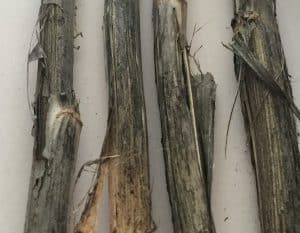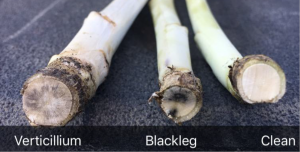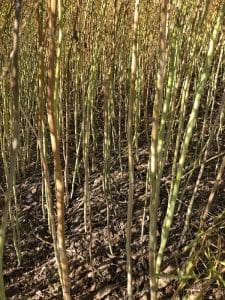Verticillium stripe, a stem disease, is showing up in more canola fields in Manitoba, Saskatchewan and Alberta, and harvest is a good time to look for it.
The fungal pathogen Verticillium longisporum causes stem cross-section discolouration that can look somewhat like blackleg and bleaching of the stem that can look somewhat like sclerotinia stem rot. But these diseases are all quite different in terms of yield risk and management, so it’s important to be able to tell them apart. (See the table and photos at the bottom.)
The good news, if you can say that about a plant disease, is that verticillium may not be a significant threat to Canadian canola production and the disease is not a regulated pest with any of our trade partners. But while we wait for new research projects to tell us more about possible yield implications, effective control measures and favourable environmental conditions, farmers and agronomists will want to learn to identify verticillium so it can be distinguished from blackleg and sclerotinia stem rot.
V. longisporum is a soil-borne fungus that infects roots and travels up the water-transporting xylem, plugging it late in the growing season. It can kill parts of or whole plants. Plants become extremely brittle and start shredding.

Symptoms are easier to identify right at or after harvest. Look for bleaching of mature stems, noting that bleaching could be on one side or all around the stem. After harvest, infected stems will have a peeling epidermis (the outer skin of the stem) with signs of microsclerotia just under that outer layer. This is a distinct symptom of verticillium stripe. Sclerotinia-infected stems will be brittle and “tissue-papery” and, when shredded open, will have larger mouse-dropping sized sclerotia inside the stem. Verticillium microsclerotia are small grey spots, almost like the specks inside a blackleg lesion, but verticillium specks are tinier, more numerous and under the epidermis while blackleg specks are always on the surface.
Harvest scouting for blackleg relies on cross-section clipping of canola stems just below ground level. (Pull them up and clip through the root tissue about a centimetre below the top of the root.) Verticillium can cause some general discolouration (greying) of the stem cross section, but it won’t have the distinct black wedges characteristic of blackleg. Eventually, grey specs (microsclerotia) will be visible in the root tissue.
Because verticillium has, so far, been more common in Manitoba, Manitoba Canola Growers Association is offering free verticillium stripe testing of canola samples submitted to the PSI Lab in Winnipeg. More information on the tests and sampling requirements. Samples are submitted under the blackleg race ID test. Other labs may also have tests to confirm verticillium, but check before sending samples.
Distinguishing verticillium stripe from sclerotinia stem rot and blackleg is important for farm management planning. If the disease is confirmed as verticillium, the microsclerotia are soil-borne, so anything that keeps soil in place – like equipment sanitation and reduced tillage – will reduce the spread of verticillium. Control measures include increasing rotation length between canola crops, management of brassica host weeds (like mustards) and increasing soil fertility to improve canola hardiness. Foliar or seed treatment fungicides to protect against verticillium are not currently registered for control in canola.
If the disease is sclerotinia stem rot, the best management is to apply fungicide to flowering canola crops when moist humid conditions favour disease development.
If the disease is blackleg, the three effective management steps are crop rotation, growing resistant cultivars and rotation of resistant cultivars. A two- or three-year break between canola crops on a field allows for the decomposition of infected canola residue, reducing the spores available to infect the next canola crop. Growing the same hybrid repeatedly on the same field will select for races of blackleg that can overcome genetic resistance in that hybrid. Rotating varieties or resistance gene groups creates the opportunity to bring a mix of major resistance genes to the field over time, which can reduce selection pressure and improve durability.


